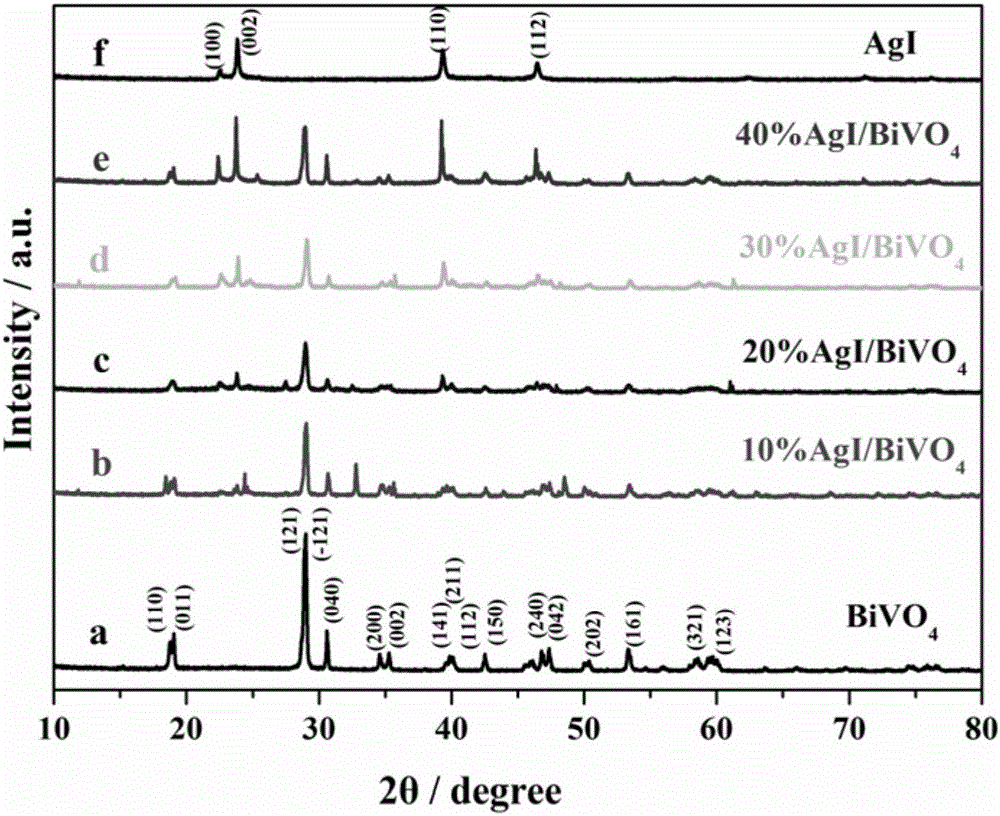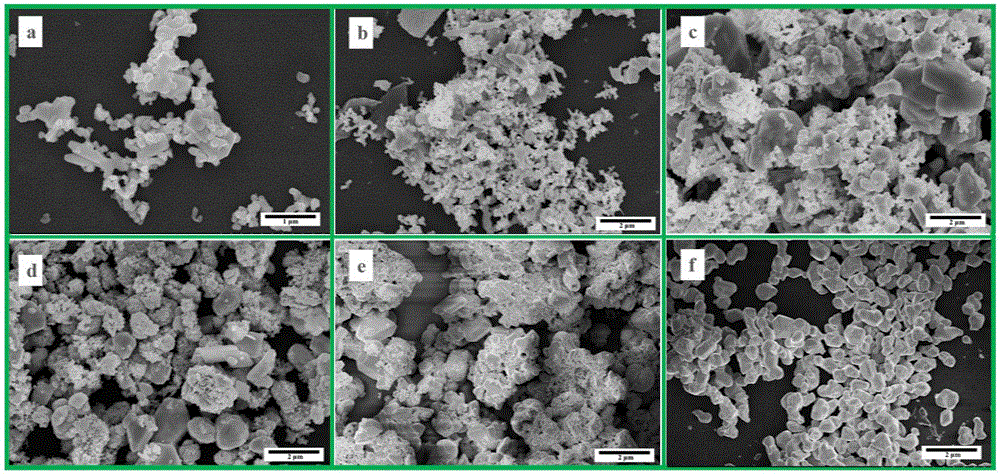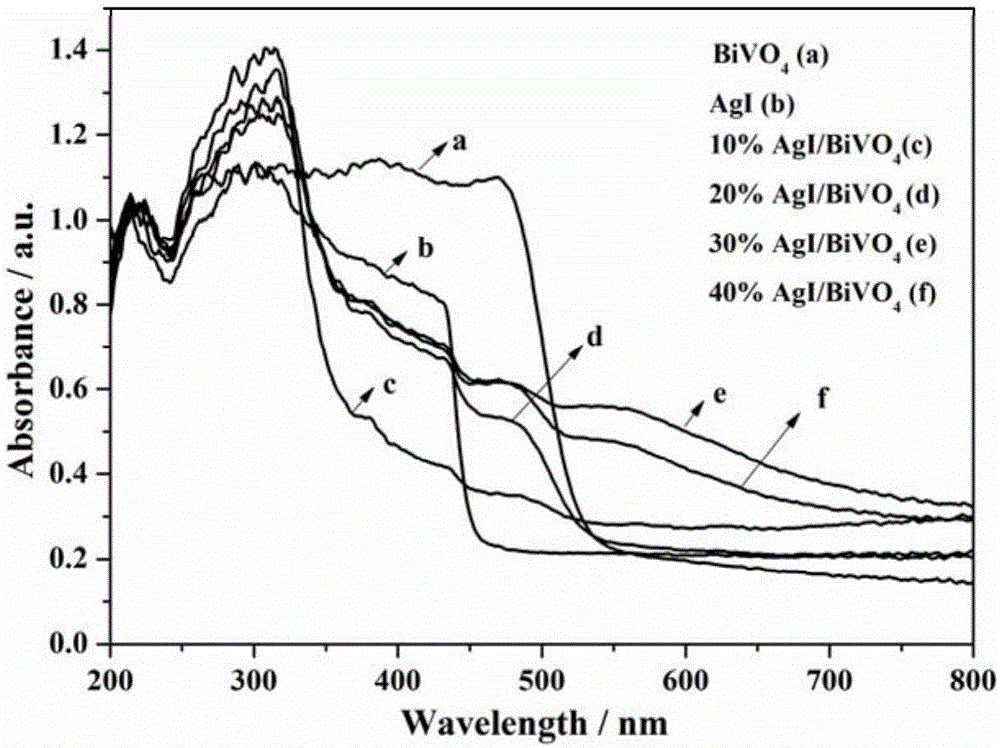Photocatalyst and preparation method and application thereof
A photocatalyst and catalyst technology, applied in the field of photocatalysis, can solve the problems of slow photoelectron-hole separation, limited photocatalytic performance of semiconductor materials, easy recombination of photogenerated carriers, and achieve low cost, good visible light absorption performance, The effect of simple preparation method and process
- Summary
- Abstract
- Description
- Claims
- Application Information
AI Technical Summary
Problems solved by technology
Method used
Image
Examples
Embodiment 1
[0039] 0.002mol of KI and 0.008mol of Bi(NO 3 ) 3 ·5H 2 O was dissolved in 40 mL of deionized water, and stirred for 30 min to obtain solution A. At the same time, 0.002moL of AgNO 3 and 0.008mol NH 4 VO 3 Dissolve in 40mL deionized water and stir for 30min to obtain solution B. Solution A was added dropwise to solution B with stirring. The above suspension was transferred to a 100mL reaction kettle after being stirred for 60min, and heated in water at 180°C for 24h. After cooling to room temperature, suction filter on a microporous membrane with a pore size of 0.45 μm, wash the product several times with ultrapure water and absolute ethanol, and place it in a vacuum drying oven at 60°C for 6 hours to obtain a sample marked as 20% AgI / BiVO 4 .
Embodiment 2
[0047] AgI / BiVO 4 Preparation method of heterojunction composite photocatalyst:
[0048] Prepared by co-precipitation and hydrothermal method, the difference from Example 1 is that the control of AgI and BiVO 4 The molar ratio of 1:9. 0.001mol of KI and 0.009mol of NH 4 VO 3 Dissolve in 40mL deionized water and stir for 30min to obtain solution A. At the same time, 0.001mol AgVO 3 and 0.009mol Bi(NO 3 ) 3 ·5H 2 O was dissolved in 40 mL deionized aqueous solution, and stirred for 30 min to obtain solution B. Solution A was then added dropwise to solution B with stirring. The above suspension was transferred to a 100mL reaction kettle after being stirred for 60min, and heated in water at 180°C for 24h. After cooling to room temperature, suction filter on a microporous membrane with a pore size of 0.45 μm, wash the product several times with ultrapure water and absolute ethanol, and place it in a vacuum drying oven at 60°C for 6 hours to obtain a sample marked as 10% Ag...
Embodiment 3
[0050] AgI / BiVO 4 Preparation method of heterojunction composite photocatalyst:
[0051] Prepared by co-precipitation and hydrothermal method, the difference from Example 1 is that the control of AgI and BiVO 4 The molar ratio is 3:7. 0.003mol of KI and 0.007mol of NH 4 VO 3 Dissolve in 40mL deionized water and stir for 30min to obtain solution A. At the same time, 0.003mol AgVO 3 and 0.007moL of Bi(NO 3 ) 3 ·5H 2 O was dissolved in 40 mL of deionized water, and stirred for 30 min to obtain solution B. Solution A was then added dropwise to solution B with stirring. The above suspension was transferred to a 100mL reaction kettle after being stirred for 60min, and heated in water at 180°C for 24h. After cooling to room temperature, suction filter on a microporous membrane with a pore size of 0.45 μm, wash the product several times with ultrapure water and absolute ethanol, and place it in a vacuum drying oven at 60°C for 6 hours to obtain a sample marked as 30% AgI / BiV...
PUM
 Login to View More
Login to View More Abstract
Description
Claims
Application Information
 Login to View More
Login to View More - Generate Ideas
- Intellectual Property
- Life Sciences
- Materials
- Tech Scout
- Unparalleled Data Quality
- Higher Quality Content
- 60% Fewer Hallucinations
Browse by: Latest US Patents, China's latest patents, Technical Efficacy Thesaurus, Application Domain, Technology Topic, Popular Technical Reports.
© 2025 PatSnap. All rights reserved.Legal|Privacy policy|Modern Slavery Act Transparency Statement|Sitemap|About US| Contact US: help@patsnap.com



